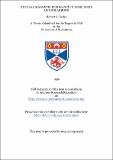Files in this item
Nuclear magnetic resonance in some solid hydrocarbons
Item metadata
| dc.contributor.advisor | Andrew, E. Raymond (Edward Raymond) | |
| dc.contributor.author | Eades, Robert G. | |
| dc.coverage.spatial | 106 p. | en_US |
| dc.date.accessioned | 2018-06-28T10:07:15Z | |
| dc.date.available | 2018-06-28T10:07:15Z | |
| dc.date.issued | 1952 | |
| dc.identifier.uri | https://hdl.handle.net/10023/14695 | |
| dc.description.abstract | The phenomenon of nuclear magnetic resonance is closely related to the molecular beam experiments and to microwave spectroscopy. Its significant feature is that the magnetic resonance principle, first applied to the molecular beam technique, has been extended to solids, liquids and gases in their normal physical states. In addition to providing yet another important method of measuring nuclear magnetic properties, this newer technique gives a means of investigating the establishment of the thermal equilibrium which is essential to the methods of obtaining very low temperatures; further, the resonance absorption spectrum yields information of crystal structures, phase transitions in solids and information about hindered rotation of molecules in solids. Thus the phenomenon can be used to study certain problems of the solid state. This thesis gives an account of such an application. | en_US |
| dc.language.iso | en | en_US |
| dc.publisher | University of St Andrews | |
| dc.subject.lcc | QC765.E2 | |
| dc.subject.lcsh | Magnetic materials | en |
| dc.title | Nuclear magnetic resonance in some solid hydrocarbons | en_US |
| dc.type | Thesis | en_US |
| dc.type.qualificationlevel | Doctoral | en_US |
| dc.type.qualificationname | PhD Doctor of Philosophy | en_US |
| dc.publisher.institution | The University of St Andrews | en_US |
This item appears in the following Collection(s)
Items in the St Andrews Research Repository are protected by copyright, with all rights reserved, unless otherwise indicated.

